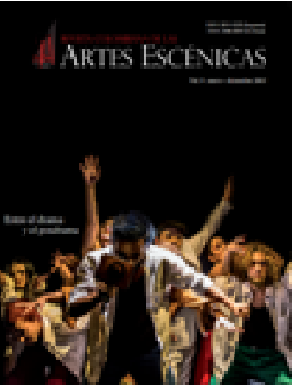Authors
Abstract
This article proposes transference of certain features of the concept of Social Production of Space to the field of the performing arts. To do this, it focuses on the concept of space produced from a socio-cultural perspective including the critical role of the body. It also presents the concept of ediation to characterize the way in which the bodies, the spaces are generated. Furthermore, it uses three concrete examples to illustrate the proposal with stage production, especifically, an assemblage conducted by the Actores en Escena group of the play My family written by the Uruguayan playwright Carlos Liscano, William Shakespeare’s tragedy Titus Andronicus and Carnage a film made by the French director Roman Polanski.
Keywords
References
Blumengebrg, H. (2001). La inquietud que atraviesa el río: ensayo sobre la metáfora. Barcelona: Editorial Península.
Burke, K. (1966). Definition of man. En Language as symbolic action: Essays on life, literature, and method (pp. 3-24). California:University of California Press.
Castedo, A. (2014, 24 de julio). La sangrienta obra de Shakespeare que hace desmayar al público. BBC Mundo. Recuperado de http://www.bbc.co.uk/mundo/
noticias/2014/07/140724_tito_andronico_desmayos_ac.shtml?print=1
Foucault, M. (1997). Los espacios otros. Astrágalo: revista cuatrimestral iberoamericana,7, 83-91.
Foucault, M. (2009). Los cuerpos dóciles. En Vigilar y castigar. Nacimiento de la prisión (pp.157-198). Iztapalapa: Siglo XXI Editores.
Geertz, C. (1991). Géneros confusos. La refiguración del pensamiento social. American Acholar, 49, 165-179.
Kosztolányi, D. (2007). Kornél Esti. Un héroe de su tiempo. Barcelona: Editorial Bruguera.
Lefebvre, H. (1974). La producción del espacio. Revista de Sociología, 3, 219-229.
Low, S. (1996). Spatializing culture: the social production and social construction of public space in Costa Rica. American Ethnologist, 23(4), 861-879.
Low S. (2003). Embodied Space(s). Anthropological theories of body, space and culture. Space & Culture, 6(1), 9-18.
Low, S. (2005). Transformaciones del espacio público en la ciudad latinoamericana: cambios espaciales y prácticas sociales. Bifurcaciones, 5,1-14.
Lucy, J., & Wertsch, J. (1987). Vygotsky and Whorf: A comparative analysis. En M. Hickmann (Ed.). Social and functional
approaches to language and thought (pp. 67-86). Cambridge, UK: Cambridge University Press.
Radford, L. (2006). Semiótica cultural y cognición. En R. Cantoral et al. (Eds.). Investigaciones sobre enseñanza y aprendizaje de las matemáticas en América Latina. Un reporte iberoamericano (pp. 669-689). México: Ediciones Díaz de Santos, S.A.
Shakespeare, W. (2001). Titus Andronicus. (Versión de F. Urdiales). Alicante: Biblioteca Virtual Miguel de Cervantes. Recuperado de http://www.cervantesvirtual.com/nd/ark:/59851/bmcnp2n7
Sperber, D. (1985). Anthropology and psychology: Towards an epidemiology of representations. Man, 20(1), 73-89.
Sullivan, N. (2003). A critical introduction to Queer theory. New York: NYU Press.
Vygotsky, L.S. (1995). Pensamiento y lenguaje.Buenos Aires: Paidós.
Wertsch, J. (1999). La mente en acción. Barcelona:Aique.

 PDF (Español)
PDF (Español)
 FLIP
FLIP









